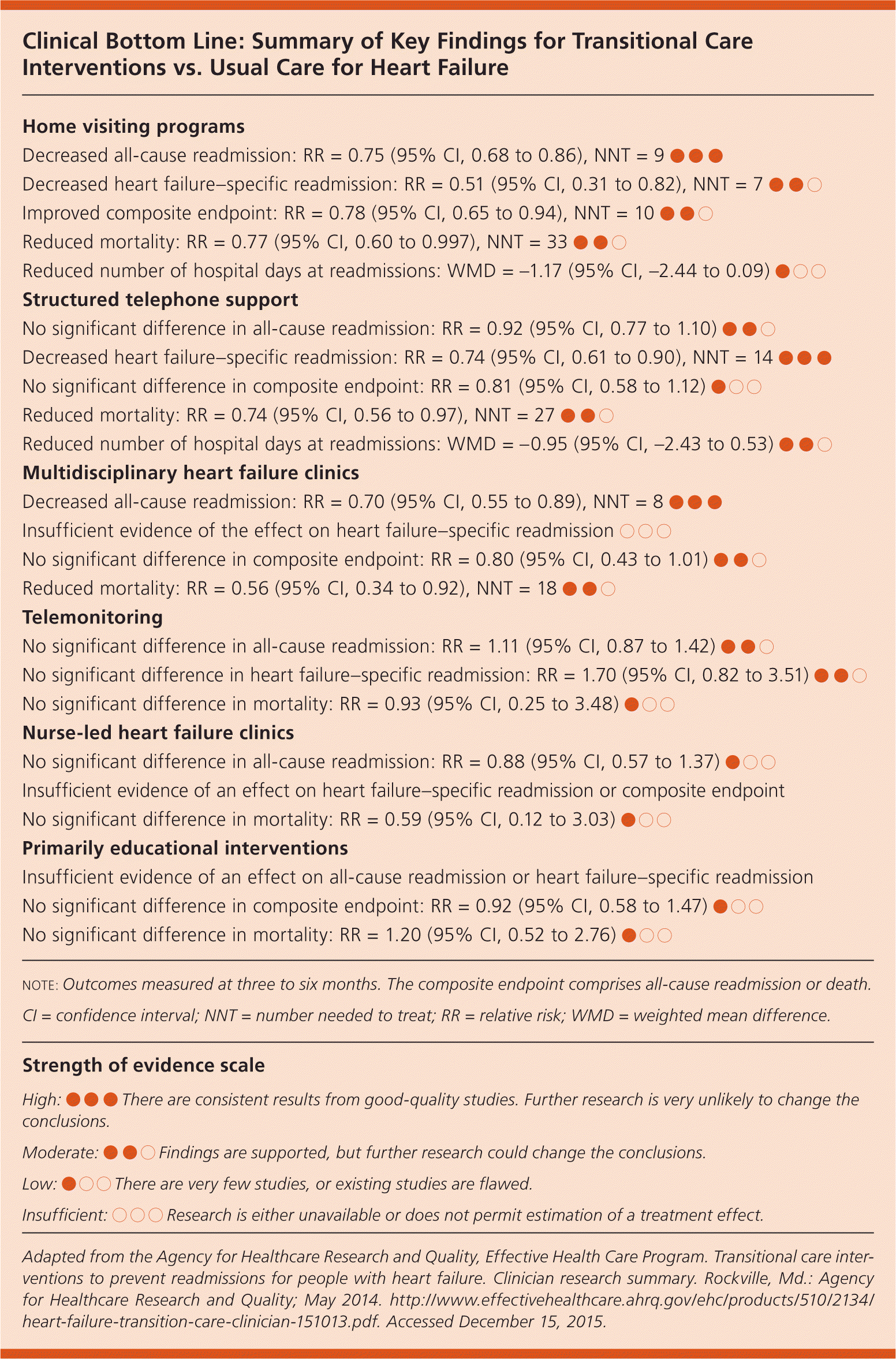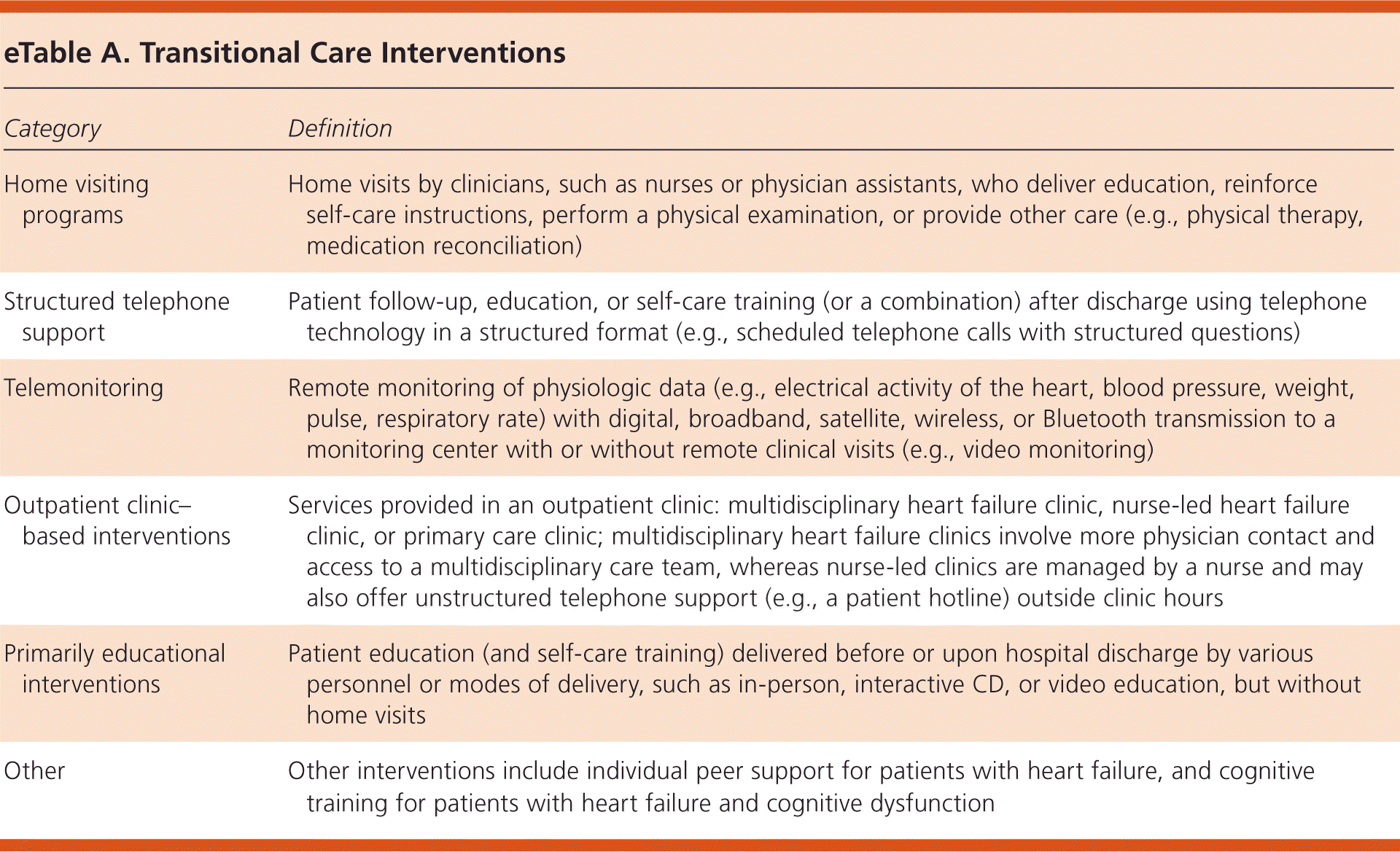
Am Fam Physician. 2016;93(5):401-403A
Author disclosure: No relevant financial affiliations.
Key Clinical Issue
What are the benefits and adverse effects of transitional care interventions that aim to reduce readmission and mortality in adult patients hospitalized for heart failure?
Evidence-Based Answer
Home visiting programs and multidisciplinary clinic interventions for adult patients with heart failure reduced all-cause readmissions and mortality over three to six months. (Strength of recommendation [SOR]: A, based on consistent, good-quality patient-oriented evidence.) Structured telephone support reduced heart failure–specific readmissions and mortality over three to six months. (SOR: A, based on consistent, good-quality patient-oriented evidence.) However, structured telephone support did not reduce all-cause readmissions over a similar period. (SOR: B, based on inconsistent or limited-quality patient-oriented evidence.)
Multicomponent interventions such as home visiting programs and multidisciplinary clinic interventions for heart failure reduced all-cause readmissions and mortality over three to six months. Key components of these interventions included heart failure education emphasizing self-care, heart failure pharmacotherapy emphasizing adherence, face-to-face contact after hospital discharge, mechanisms for postdischarge medication adjustment, and streamlined mechanisms to contact care delivery personnel (e.g., a patient hotline). These higher-intensity interventions were delivered by teams of clinicians.

| Home visiting programs |
| Decreased all-cause readmission: RR = 0.75 (95% CI, 0.68 to 0.86), NNT = 9 ● ● ● |
| Decreased heart failure–specific readmission: RR = 0.51 (95% CI, 0.31 to 0.82), NNT = 7 ● ● ○ |
| Improved composite endpoint: RR = 0.78 (95% CI, 0.65 to 0.94), NNT = 10 ● ● ○ |
| Reduced mortality: RR = 0.77 (95% CI, 0.60 to 0.997), NNT = 33 ● ● ○ |
| Reduced number of hospital days at readmissions: WMD = −1.17 (95% CI, −2.44 to 0.09) ● ○ ○ |
| Structured telephone support |
| No significant difference in all-cause readmission: RR = 0.92 (95% CI, 0.77 to 1.10) ● ● ○ |
| Decreased heart failure–specific readmission: RR = 0.74 (95% CI, 0.61 to 0.90), NNT = 14 ● ● ● |
| No significant difference in composite endpoint: RR = 0.81 (95% CI, 0.58 to 1.12) ● ○ ○ |
| Reduced mortality: RR = 0.74 (95% CI, 0.56 to 0.97), NNT = 27 ● ● ○ |
| Reduced number of hospital days at readmissions: WMD = −0.95 (95% CI, −2.43 to 0.53) ● ● ○ |
| Multidisciplinary heart failure clinics |
| Decreased all-cause readmission: RR = 0.70 (95% CI, 0.55 to 0.89), NNT = 8 ● ● ● |
| Insufficient evidence of the effect on heart failure–specific readmission ○ ○ ○ |
| No significant difference in composite endpoint: RR = 0.80 (95% CI, 0.43 to 1.01) ● ● ○ |
| Reduced mortality: RR = 0.56 (95% CI, 0.34 to 0.92), NNT = 18 ● ● ○ |
| Telemonitoring |
| No significant difference in all-cause readmission: RR = 1.11 (95% CI, 0.87 to 1.42) ● ● ○ |
| No significant difference in heart failure–specific readmission: RR = 1.70 (95% CI, 0.82 to 3.51) ● ● ○ |
| No significant difference in mortality: RR = 0.93 (95% CI, 0.25 to 3.48) ● ○ ○ |
| Nurse-led heart failure clinics |
| No significant difference in all-cause readmission: RR = 0.88 (95% CI, 0.57 to 1.37) ● ○ ○ |
| Insufficient evidence of an effect on heart failure–specific readmission or composite endpoint |
| No significant difference in mortality: RR = 0.59 (95% CI, 0.12 to 3.03) ● ○ ○ |
| Primarily educational interventions |
| Insufficient evidence of an effect on all-cause readmission or heart failure–specific readmission |
| No significant difference in composite endpoint: RR = 0.92 (95% CI, 0.58 to 1.47) ● ○ ○ |
| No significant difference in mortality: RR = 1.20 (95% CI, 0.52 to 2.76) ● ○ ○ |
Practice Pointers
Heart failure is one of the most common causes of hospital admissions, and one-fourth of patients hospitalized with heart failure are readmitted within 30 days.1 In an effort to reduce these readmissions, the Centers for Medicare and Medicaid Services has lowered hospital reimbursement for readmissions and provided incentives for systems that have implemented effective post–hospital discharge transition programs.2 eTable A summarizes different types of transitional care interventions.

| Category | Definition |
|---|---|
| Home visiting programs | Home visits by clinicians, such as nurses or physician assistants, who deliver education, reinforce self-care instructions, perform a physical examination, or provide other care (e.g., physical therapy, medication reconciliation) |
| Structured telephone support | Patient follow-up, education, or self-care training (or a combination) after discharge using telephone technology in a structured format (e.g., scheduled telephone calls with structured questions) |
| Telemonitoring | Remote monitoring of physiologic data (e.g., electrical activity of the heart, blood pressure, weight, pulse, respiratory rate) with digital, broadband, satellite, wireless, or Bluetooth transmission to a monitoring center with or without remote clinical visits (e.g., video monitoring) |
| Outpatient clinic–based interventions | Services provided in an outpatient clinic: multidisciplinary heart failure clinic, nurse-led heart failure clinic, or primary care clinic; multidisciplinary heart failure clinics involve more physician contact and access to a multidisciplinary care team, whereas nurse-led clinics are managed by a nurse and may also offer unstructured telephone support (e.g., a patient hotline) outside clinic hours |
| Primarily educational interventions | Patient education (and self-care training) delivered before or upon hospital discharge by various personnel or modes of delivery, such as in-person, interactive CD, or video education, but without home visits |
| Other | Other interventions include individual peer support for patients with heart failure, and cognitive training for patients with heart failure and cognitive dysfunction |
This Agency for Healthcare Research and Quality review analyzed 47 randomized controlled trials (RCTs) of more than 5,000 participants addressing the effectiveness of transitional care interventions to prevent hospital readmissions (all-cause and heart failure–specific) and mortality at three to six months.3 Transitional care interventions examined in this review included structured home visits, telephone support, telemonitoring, outpatient clinic visit interventions, and educational interventions. The trials included older adults with mostly moderate to severe heart failure (New York Heart Association class III or IV); the mean age of patients in the trials was in the 70s. The generally moderate- to high-intensity transitional interventions were compared with usual care.
A meta-analysis of 15 RCTs of home visiting programs showed a statistically significant 25% reduction in all-cause readmissions (nine trials, n = 1,563; number needed to treat [NNT] = 9) and a 49% reduction in heart failure readmissions (one trial, n = 282; NNT = 7); there was a statistically significant reduction in mortality (eight trials, n = 1,693; NNT = 33). Home visiting programs generally included five or more home visits, with or without predischarge educational sessions or individualized discharge planning.
A meta-analysis of 13 RCTs of structured telephone support showed a statistically significant 26% reduction in heart failure–specific readmissions (seven trials, n = 1,790; NNT = 14) and mortality (seven trials, n = 2,011; NNT = 27); there was no significant difference in all-cause hospital readmissions (eight trials). In these studies, pharmacists or nurses provided telephone support to patients on similar call schedules (e.g., weekly for one month following hospitalization, then biweekly for two or three months) with an optional patient hotline available.
A meta-analysis of seven RCTs of multidisciplinary heart failure clinics showed a 30% reduction in all-cause readmission (two trials, n = 336; NNT = 8) and a 44% reduction in mortality (three trials, n = 536; NNT = 18). The heart failure clinics included scheduled regular visits with multiple clinicians during the visits, as well as additional visits based on patient need.
Telemonitoring programs did not affect all-cause or heart failure–specific hospital readmissions or mortality rates. Nurse-led heart failure clinics did not affect all-cause readmissions or mortality rates, and primarily educational interventions did not affect mortality rates. Because few studies report any individual outcome, there was insufficient evidence to determine the effect of educational interventions and nurse-led heart failure clinics on heart failure–specific readmission rates.
The strongest evidence supports high-intensity home visiting programs, structured telephone support, and multidisciplinary heart failure clinics. High intensity (defined as greater duration, frequency, or periodicity of patient contact), face-to-face delivery, and multidisciplinary team involvement appear to be key elements of successful interventions, regardless of intervention type.
A recent systematic review also concluded that high-intensity interventions are associated with reduced hospital readmissions, regardless of duration.4 The American Heart Association recommends systematically implementing the following transitional care interventions in high-risk patients with chronic heart failure: medication reconciliation, very early postdischarge contact (within 24 to 72 hours), early office follow-up (within a few weeks of discharge), patient education starting in the hospital, health record communication with the patient and clinicians, and interdisciplinary collaboration and coordination.5
editor's note: American Family Physician SOR ratings are different from the AHRQ Strength of Evidence (SOE) ratings.
